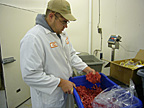March 07, 2011
Student tries to build a better hot dog
CARBONDALE, Ill. — Someone has to invent all those new ready-to-eat meat products that are replacing the standard roasts and chops in shoppers' grocery carts. Russell O. McKeith thinks he's a guy who could do it.
McKeith, a senior in animal science at Southern Illinois University Carbondale, has already tried his hand at helping develop what he called "a whole smorgasbord of products," including sloppy Joes, stuffed ham and pre-cooked pork chops, during an internship at Smithfield Packing Co. in Virginia last summer.
"I decided after an internship in a microbiology lab the year before that I didn't want to be a 'lab rat' the rest of my life," McKeith said.
"I got interested in research and development — helping develop products is what I really enjoy."
An undergraduate research grant through SIUC's REACH program allowed him to try his hand at altering that iconic American favorite, the hot dog. True, it's a popular food already. According to ThomasNet.com, which tracks market trends, we eat more than 350 million pounds of hot dogs each year; they appear on 95 percent of this country's dinner tables. But nothing's so good it can't be improved.
McKeith's idea was to see how acidity, or pH levels, would affect traits such as taste, texture, color and shelf life. He figured if he could find an acidity level high enough to kill the bacteria that shorten shelf life without losing consumer appeal, he'd have something of interest to the trade. It wouldn't hurt his chances at grad school, either.
"There's no research out there comparing lower pH hot dogs with higher pH hot dogs," McKeith said.
His original proposal called for altering pork dogs with sodium bicarbonate — common baking soda. But Smithfield's vice president of research and development suggested phosphates instead.
"He said sodium bicarbonate would make the hot dogs taste soapy and I could use greater differences in pH with phosphates," McKeith said.
McKeith also decided to go with beef hot dogs rather than pork — according to the National Hot Dog and Sausage Council, 60 percent of those it surveyed preferred beef — in order to avoid skewing tasting panel results at the outset.
McKeith cooked up his own hot dogs from scratch last September with the help of some folks at the University of Illinois in Urbana-Champaign, where his father teaches meat science. He made four types: a more acidic dog (low pH), a middle-of-the-road dog, a less acidic dog (high pH) and one that he didn't tinker with at all.
He found the high pH dog had a better texture; the more acidic dog tended toward mushiness. His consumer panel, mostly SIUC students — many of whom got extra credit for volunteering their taste buds to the service of science — liked the taste of the high pH dog better, though they preferred the color of the low pH dog. McKeith thinks he knows why.
"(The low pH hot dog) resembled the cheaper hot dogs, and since they don't have much money, those are the ones they're used to," he speculated.
As for shelf life, McKeith checked his samples for bacteria after three, six, nine and 15 weeks; his findings surprised him.
"There really wasn't a significant difference (in bacterial) counts between the treatment groups," he said.
Karen L. Jones, the SIUC animal scientist who served as McKeith's REACH mentor, said his project demonstrated the possibilities for joint projects with University of Illinois counterparts.
"SIUC does not have a meat program so this study could not have been conducted here," Jones, who is on sabbatical this term, wrote in an e-mail.
"I hope that this experience is the beginning of a new tradition of collaboration. We were after the same goal — to get information to the meat processors that will balance what the consumer wants while still maintaining product safety and shelf life."
McKeith will present his findings this June at the American Meat Science Association's conference in Gainesville.
"When Russell gives his presentation, he will be directly addressing the audience he wants to educate—hot dog manufacturers." Jones commented.
"In addition, the experience of presenting his work is a critical part of the scientific process and will better equip him in the skills necessary for graduate school. He never did the work if no one knows about it!"
McKeith also hopes to write an article based on his research and submit it to several professional journals.
In the meantime, the work already has produced one solid result. This fall, he'll be heading to the University of Georgia to begin a master's program in meat science.
Caption:
Hot diggity dog! — To whip up his experimental hot dogs, Russell O. McKeith, a senior in agriculture at Southern Illinois University Carbondale, reaches into a mixture of beef and fat and sodium bicarbonate. Though not Salukis, these "dawgs" played a starring role in McKeith's research aimed at discovering how acidity, or pH levels, would affect hot dogs' taste, texture, color and shelf life.
Photo provided by Russell O. McKeith

